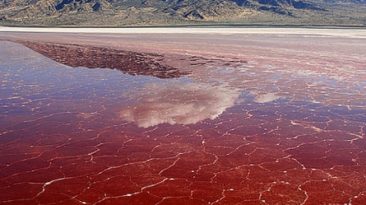Is your speed in water unmatched? Does your breaststroke leave your opponents in last place? Maybe you’re ready for a different challenge.
So, what if you jumped into a pool full of honey? Would you sink to the bottom? Could you eat during your swim? And is honey just bee spit?
In 2005, Professor Edward Cussler received the Ig Nobel Prize for comparing swimming speeds in syrup versus water. He found that although the syrup was denser than water, the swimmers’ increased motion made the liquid more viscous, or flow more easily.
So as the swimmers kept moving, the syrup became just as easy to swim through as water. But if you stop moving, when the honey thickens, could you drown?
Made from nectar, honey is the result of tireless work and millions of flowers. Each bee collects nectar from flowers and stores it inside its extra stomach, known as its crop.
After it mixes with enzymes inside the bee, the new chemical is ready for long-term storage. So, when it returns to the hive, the bee regurgitates the fluid into another bee’s mouth, and that bee passes it to another bee, creating a daisy chain of partially digested nectar.
This process continues until a bee deposits the fluid into a honeycomb. After the water has evaporated, bees seal the comb with a secretion from their abdomens, which hardens into beeswax.
So if you want to fill an Olympic-sized pool, how much honey would you need? Well, the pool would hold about 3,000,419 liters (660,000 gal) of water, so you’d need about 4.35 million kg (almost 9.9 million lb) of honey.
So, considering that one bee colony produces 27-45 kg (60-100 lb) of honey per year, this pool would contain many colonies’ lifetimes of work. Honey is a non-Newtonian fluid, named after the famous physicist Sir Isaac Newton.
You know, the apple and gravity guy. He found that normal fluids, like water, have a constant flow with no resistance, or viscosity. We call those Newtonian fluids. But we’re dealing with honey.
As a non-Newtonian fluid, it’s viscosity changes when you apply force to it, such as the impact of you swimming in it. And the thicker the liquid, the higher the viscosity.
Centipoise measures the amount of force needed to move a layer of liquid in relation to another liquid. On a mild, 21°C (70°F) day, honey has a viscosity of 10,000 cps, but water is only 1 cps. Oh, and honey is 1.5 times denser than water too.
But honey is also thixotropic fluid, which means if it stays still, it becomes a gel-like substance. So that could slow you down. If you want an easier swim through honey, you’ll need a warm day.
While your cannonball wouldn’t have the same splash as in water, the sudden movements of your arms and legs would begin to change the honey’s composition. And since the buoyant force increases with density, you may float back to the top after you jump in.
So that makes it less likely that you’ll drown. Professor Cussler’s experiment showed that form drag is key to human swimming. Your form, or shape, affects the drag on your body when you’re moving through a fluid, like swimming through honey.
Streamlined shapes have less drag when they move through fluids. And since we’re all shaped differently, the drag you create in the honey is unique to you. No judgement here.
You might want to break out your cap and Speedo bathing suit to lessen the resistance while you swim. And you may even have a snack between laps. You’ll get more than a mouthful of honey while you’re swimming.
But take it easy. If you eat too much, you could get sick. While honey has been used to treat everything from coughs to wounds, consuming too much could cause health problems. Considering the recommended allowance of honey is 10% of your daily calories, all this added sugar pouring into your body could make you queasy.
And even more dangerous, every gulp comes with the threat of botulism, a kind of food poisoning. These spores grow in improperly preserved food, and create a toxin that attacks the body’s nerves.
It can weaken the muscles you use for breathing and even kill you. But there are some benefits. One dip might leave you sticky. If you make this swim part of your morning routine, your skin could become softer and well-moisturized.
Your abrasions would heal faster, and you would have fewer fungal infections. This tasty, gel-like fluid has just as many restorative properties as it does drawbacks. Used in moderation, it could help your body inside and out.
But if you swim in honey too often, it might cancel the healthy benefits. Of course, without honeybees, we wouldn’t have the option of floating in this sticky stuff. It makes you wonder, what if insects disappeared from the planet?
Sources
- “Olympic Swimming Pools – Phinizy Center For Water Sciences”. Sherman, Camilla. 2016. Phinizy Center For Water Sciences.
- “Viscosity Scale”. 2021. smooth-on, inc..
- “What would happen if someone jumped into a pool full of honey?”. 2021. quora.com.
- “Non-Newtonian Fluids And Their Properties”. 2021. Science.



























